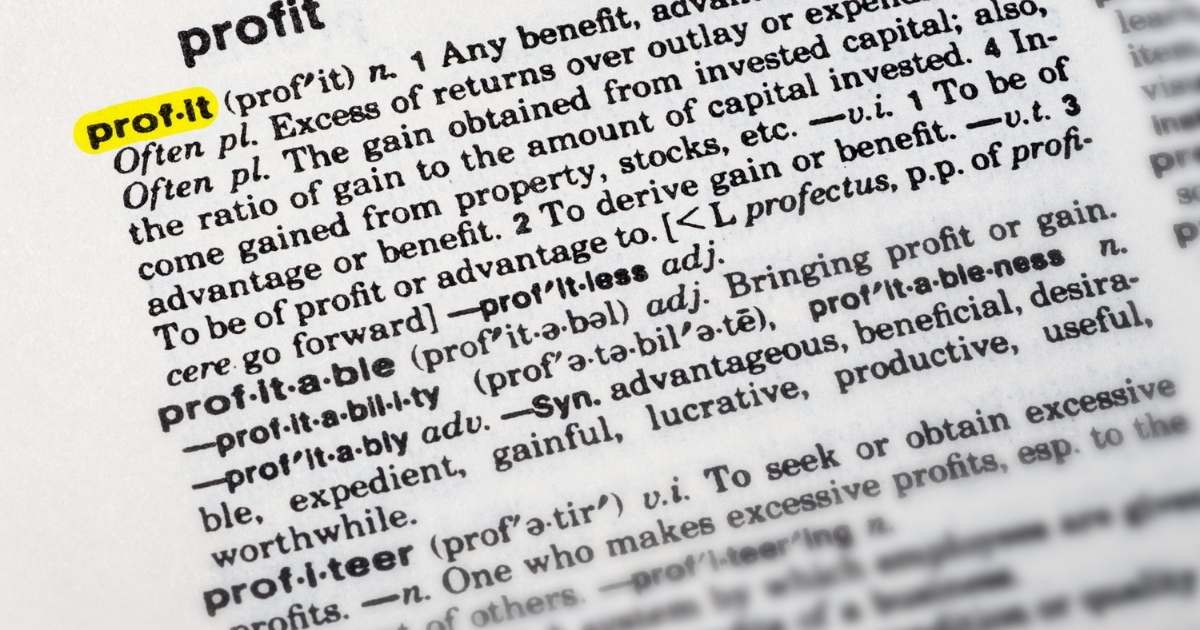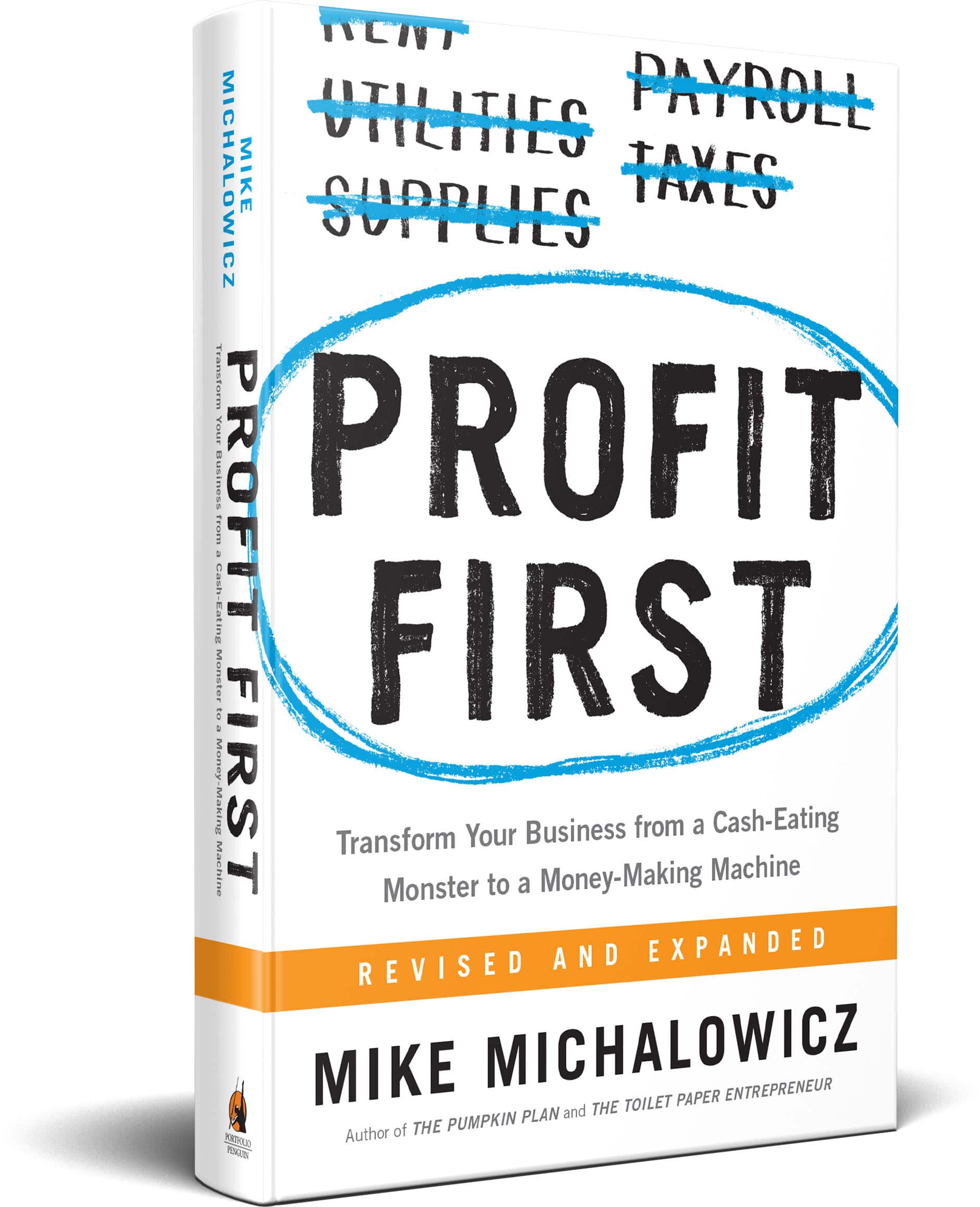What is Profit First Accounting? (An Overview)
Running a business is hard work, there never seems to be enough cash to pay all the suppliers AND the employees, let alone you as the business owner. There was cash in the bank, but it’s all gone again and your accountant has just informed you that you owe the ATO for the tax on last year’s profits. It’s depressing, stressful, frustrating and it needs to change. Wouldn’t be amazing if, in a few short months, you could say ‘I got a dividend from my business last week and I really know how much cash I have and for what purpose!’? Implementing Profit First accounting may just do that for you!
If you are reading this, you have probably heard of the book Profit First written by acclaimed business author Mike Michalowicz (author of other bestsellers The Pumpkin Plan, The Toilet Paper Entrepreneur, Surge, Run Like Clockwork and Fix This Next). In his own words, Mike’s mission is to “eradicate entrepreneurial poverty”. If you haven’t read any of the book, you can download the first 2 chapters, completely FREE!
We find that a great many business owners who have heard of or have read the book, feel that they need a bit of guidance before they introduce Profit First into their businesses. Once they do, they never look back.
So, our purpose with this article is to provide you with a brief overview of the book, give you a basic understanding of the premise and principles that shape the book and provide a 3-step basic implementation process. Further articles will expand on some of the aspects briefly explained below, so stay tuned!

A Basic Profit First Summary
Let’s get straight to the point! If you’re in business you will be familiar with looking at the annual accounts given to you by your accountant (often months after the year end, so really they are only useful for dealing with the ATO). It will start with turnover at the top of the page, then list a multitude of expenses before finally ending with (hopefully) profit. You may look at the profit figure, look at your bank account balance and think, what profit? I didn’t take any profit, so where’s the money gone?
Sales – Expenses = Profit may add up and it’s what we are all used to, but it puts the most important aspect of owning a business (the PROFITS) last. In Profit First accounting, the basic premise is that PROFIT is more important than a final, hoped for, consideration. What if, therefore, we change the philosophy of running a business to:
Sales – Profit = Expenses
Take ‘profit first’ and run the business on what is left. If you can do that, then you will be permanently profitable.
Interested? Great, let’s go through the basic principles and implementation plan.
Human Behaviour
Your accountant may well have advised you to constantly review your profit and loss account, your balance sheet and examine various ratios to see how your business is performing. Do you though? Or do you, like most of us just look at the bank balance when you log on to the bank?
We all know plenty of business owners that rarely log into their accounting software, I’ve known some that never do!
This advice rarely works for business owners because the vast majority of business owners aren’t accountants and you don’t find playing with numbers that interesting! (Accounting is an art, not a science! I should know, my accounting degree is an arts degree!) What matters is how much money is in the bank and do you have enough to pay yourself, your bills and your employees.
By accepting that human behaviour (emotions) are central to how you operate your business and therefore the business finances. Mike Michalowicz, in the book, looks at how you can utilise your normal behaviour to better control your business finances and achieve permanent profitability.

The Four Core Principles of Profit First
The four core principles are listed in the book as:
- Use small plates;
- Serve sequentially;
- Remove temptation; and
- Enforce a rhythm.
Let’s understand what each core principle is.
Small Plates
If a client gives you a week to complete a project, do you use the whole week?
But if the same project had a one day deadline would you still complete it in a day?
For a great many of us, we will use time, money or whatever resource to the maximum in order to complete a project. This is Parkinson’s Law in action. Parkinson’s Law (named after C. Northcote Parkinson) is the counterintuitive premise that demand for something expands to match its supply.
I see this in operation in many businesses. The business receives $5,000 in a week and spends all of it. The next week it receives $4,000 and spends all of that, the following week $8,000 and again, it is all spent. My business used to do this, yours probably does now.
What would happen if, when you receive $5,000 in a week you take out just $50 (1%) and put it away somewhere safe. You now have a ‘smaller plate’ to run your business with. Would your business survive on the $4,950 left? I bet it would!
Serve Sequentially
It was mentioned earlier in the ‘basic premise of Profit First’ that by altering the old accounting formula of Sales – Expenses = Profit to Sales – Profit = Expenses this automatically gives more importance to Profit. As the book explains, this is to do with another behavioural principle known as the ‘Primacy Effect’. The primacy effect is where we place greater emphasis or significance on whatever we encounter first.
By placing Profit before Expenses we place greater emphasis on it. To quote Mike Michalowicz “When profit comes first, it is the focus, and it is never forgotten” (p41 Profit First).
Remove Temptation
Many of us are highly tempted by some particular item of confectionery. For me, it’s Cadbury’s Fruit and Nut Chocolate. If I see a bar in the house then I’m going to eat it (or if my will power is particularly strong at that moment, maybe I’ll only eat a ‘reasonable amount’ of it – but I’ll be back later!). For Mike Machalowicz, in the book, it was a chocolate bar from his childhood.
Therefore, it follows that if the $50 that you took as Profit from the $5,000 that you received this week is sitting in an account that you can see when you log on to your bank, you will transfer it into your transaction account just like you do with your existing savings account and spend it.
Just as with chocolate (or a bottle of Yorkshire Bitter etc.) ‘out of sight equals out of mind’ is a powerful and effective force. By removing the $50 profit and putting it in a totally different bank, then you won’t see it and therefore you won’t access it.
“..just like anything that you don’t have a reasonable degree of access to, you will find a way to work with what you have and not worry about what you don’t” (p42 Profit First).
Enforce a Rhythm
Over the last 30+ years helping hundreds of business owners, I have come across many that are so stressed by cash (or more accurately, so stressed by a lack of cash) that they will check bank accounts every day, pay suppliers whatever they have every day and hope that there is more in the bank tomorrow. Daily ‘hand to mouth’ operating of cash will never get you ahead and will never lead to cash being available to reward you with a dividend for your investment in your own business.
The final core principle is all about creating or finding a cash rhythm that works for your business and sticking to it. The rhythm could be weekly, fortnightly, Profit First advocates bi-monthly (10th and 25th of each month) or monthly.
The aim is to accumulate your sales income and then allocate it and spend it according to your business rhythm. In part your business rhythm will be influenced by your payroll and/or supplier payment cycle, if you pay your staff fortnightly and can do the same for suppliers then this will probably be the right rhythm for you.
When you have a cycle, you will quickly come to understand how much cash you need each week, fortnight or month. A two second check of your bank account that your income accumulates in, will very quickly inform you where you stand and whether you need to take any action.

Basic Implementation – a 3 Step Process
Ok, so we now know and understand the behavioural why Profit First accounting works for so many businesses and business owners. Let’s move on and look at a 3 step process that will explain how you can implement Profit First in your business as I have in my own and for many clients.
Step 1 – Open & Organise Bank Accounts
You’re probably going to need a few more bank accounts and also probably a second bank, but when I think back to how long it took to open up a new bank account 30 years or so ago, this really isn’t an impediment to starting your Profit First journey and you will be well rewarded!
At the very least you will need the following accounts (change banks if they want to charge you for having more than one account!):
Bank 1:
- INCOME – a transaction account that all your revenue is paid into;
- GST – a transaction or saving account to hold the GST collected on revenue received. NOTE this account isn’t necessary if you aren’t registered for GST. I also transfer any Superannuation and tax withheld from wages into this account so that it is all in the one spot when it’s time to pay the ATO;
- OWNER PAY – a transaction or saving account to cover payments for your salary, motor vehicle or pay personal costs;
- MATERIALS – a transaction account used to pay suppliers or subcontractors of materials and services that you either use in manufacturing or resell. NOTE this account isn’t really necessary if these costs are less than 25% of the Income;
- OPEX – a transaction account used to pay all other operational expenditure, e.g. Rent, Staff costs etc.
Your existing trading account will become either your INCOME or your OPEX account. This depends on whether it is easier to move your customers to a new account or transfer any direct debits etc. to a new account.
Bank 2:
- PROFIT – a saving account for holding the PROFIT allocation, half of which is distributed quarterly to the business owner with the balance being held as a buffer against business downturns;
- TAX – a saving account for holding the TAX allocation and used to pay business tax liabilities.
I understand that this is a lot of accounts, but it will bring clarity of thought when you are looking at how much money you have in the bank and whether you can spend it. A rule is that you do not transfer from one account to another if an account is short of funds. If an account is short that means that the Company is overspending compared to its Revenue and that potentially means losses and Business Owner personal liability.
Oh, and if you will be tempted to ‘borrow’ from the GST account to pay anything other than your BAS (and Super), you’d better stick that account in bank 2 as well!
If you want some in depth information on setting up your bank accounts, take a look at the video I made on that topic next.
Step 2 – Instant Assessment
Right, all the forms have gone in to open up the new accounts. If you’re waiting on the accounts to open don’t wait for that to happen before you move to Step 2. Let’s crack on because this is the fun part where you get to work out how fiscally elite (or not) your business is. It’s also the nitty gritty part and you will need some reports to work with from your accounting system, such as last year’s Profit and Loss account (on a cash basis, remember Profit First is all about cash, not accounting matters such as accruals, prepayments and depreciation), tax assessments and bank records.
Below, are a couple of tables that the Profit First business model utilises to assess your business. To assist with your understanding of the tables, I’ve included the following explanations to the terminology used that will allow you to complete the ‘ACTUAL’ column in the Instant Assessment Template. Think of these as like a Profit First calculator that you can easily set up yourself.
- Total Revenue (cell A1) – the total revenue generated by the business (net of GST);
- Material & Subs (cell A2) – Cost of any materials or sub-contract labour (not employees) used to make items that you cell. If this is less than 25% of your Total Revenue, enter 0 and add these costs to OPEX (below);
- Real Revenue (cell A3) – Top Line (total revenue, cell A1) less the cost of materials and any subcontracted labour (cell A2) used to produce the materials or services that you sell;
- Profit (cell A4) – funds either set aside or distributed to the business owner(s) as a reward for investing in the business. This is not your accounting profit, only include any cash that is actually set aside for distribution or has actually been distributed;
- Owner’s Pay (cell A5) – total amount paid to the owner(s) of the business as a reward for their work in the business. This includes wages/salary, superannuation and any expenditure that may otherwise be considered personal in nature e.g. own car expenses;
- Tax (cell A6) – funds either set aside or paid in respect of tax on business profits(not GST);
- OPEX (cell A7) – Operating expenditure of the business, essentially this is all other expenditure that is not detailed in any of the other categories above. It includes staff costs, rent, software etc.
Instant assessment template:
| ACTUAL | TAP | PF$ | DELTA | FIX | |
| Top Line Revenue | A1 | ||||
| Materials & Subs | A2 | ||||
| Real Revenue | A3 | 100% | C3 | ||
| Profit | A4 | B4 | C4 | D4 | E4 |
| Owner’s Comp | A5 | B5 | C5 | D5 | E5 |
| Tax | A6 | B6 | C6 | D6 | E6 |
| OPEX | A7 | B7 | C7 | D7 | E7 |
More explanations:
- TAP (cells B4 to B7) – Profit First calculated Target Allocation Percentage, this is the % of ‘Real Revenue’ that fiscally elite businesses spend. The Profit First percentages are in the table below and are determined by the scale of your business’s Real Revenue (see table below);
- PF$ (cells C3 to C7) – this is a calculation of your ‘Real Revenue’ (cell A3) multiplied by the TAP (cells B4 to B7) i.e. Owner’s Comp cell C5 equals cell A3 multiplied by cell B5. Cell C3 will always equal cell A3.
- DELTA (cells D4 to D7) – this is the difference between column A and column C. It is column A minus column C. If cell A4 is $5,000 and cell C4 is $25,000, then cell D4 will be -$20,000.
- FIX (cells E4 to E7) – if the corresponding cell in column D is negative, then you just enter INCREASE as you need to increase the amount of revenue that you are allocating to this ‘cost’. If the figure is positive, then enter DECREASE because you will need to decrease the amount of revenue that you are allocating to this cost.
General Target Allocation Percentage (TAP) table:
| Real Revenue Range | <$250k | $250k-$500k | $500k-$1m | $1m-$5m |
| Profit | 5% | 10% | 15% | 15% |
| Owner’s Comp | 50% | 40% | 30% | 15% |
| Tax | 15% | 15% | 15% | 15% |
| OPEX | 30% | 35% | 40% | 55% |
Once you’ve entered your numbers in the cells and completed the calculations, don’t worry if Profit, Owner’s Comp and Tax all say INCREASE in the FIX column. The vast majority of businesses are in this position. The great thing is, is that you know it and now you can start thinking about fixing it.
If your Profit, Owner’s Comp and Tax all say DECREASE in the FIX Column, guess what? You’re the elite of the fiscally elite! Or you’re running yourself and your employees into the ground….
Step 3 – Start Out Easy
In the book, Mike recommends starting out slowly as you move your business from where you are towards being fiscally elite. Simply allocate 1% more of your real revenue to Profit, Tax and Owner’s Pay than you have historically done. Start to look to reduce your expenditure or increase your prices/margin to achieve this small adjustment. This is especially important for small business money management.
Look at reducing expenditure by examining all your costs and start to cut out anything that you don’t need or reduce subscriptions for items such as mobiles to the level that you use, not the level that you thought you would use.
If you find a big ticket item that you don’t use and can stop spending on, fantastic, but for most businesses, it’s about chipping away. Besides, even if you found a big ticket saving, it shouldn’t stop you from chipping away at the other costs.
You should not look to suddenly change your spending, this will likely lead you to start getting short of cash in your OPEX and will result in the temptation to rescue it with cash from your Profit or Owner’s Comp account. Take small steps, maybe look to set a plan over two years, maybe even longer.
Moving Beyond the Basic Implementation
As the book explains, Profit First accounting is not just about quickly allocating funds to a Profit or Owner’s Comp account. It also expands on the process to drive down debt, introduces drip accounts to manage advance payments and deposits for future work and a host of other accounts that can bring financial clarity to your business.
Remember that there are a number of Certified Profit First Professionals, specifically and professionally trained in the Profit First formula to help you in your journey.
If we can be of assistance, please book a call and I will help you get your business to permanent profitability!
Download the first two chapters of Profit First here





